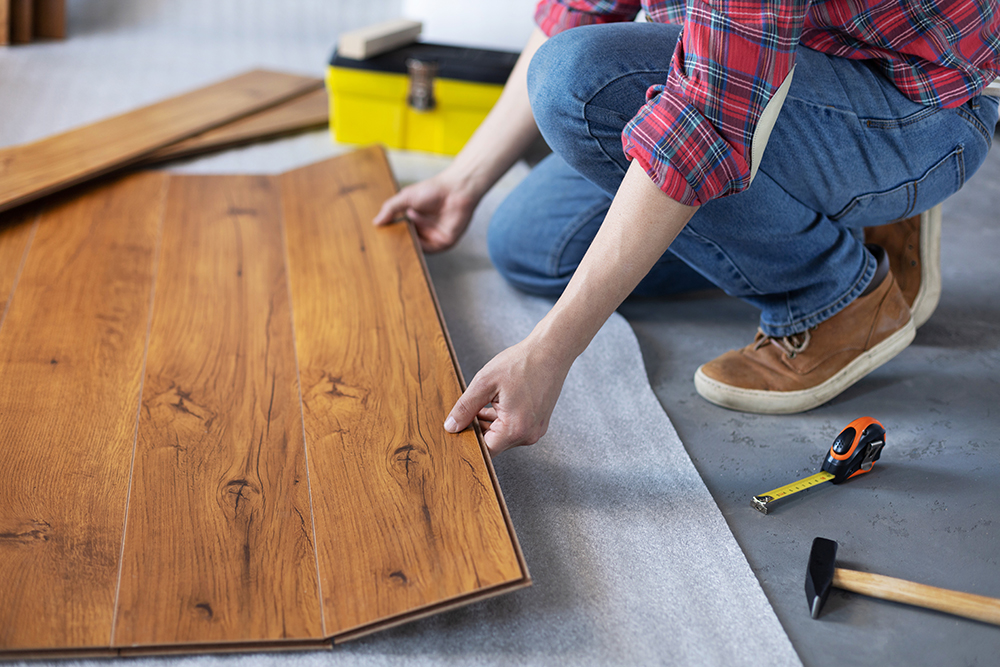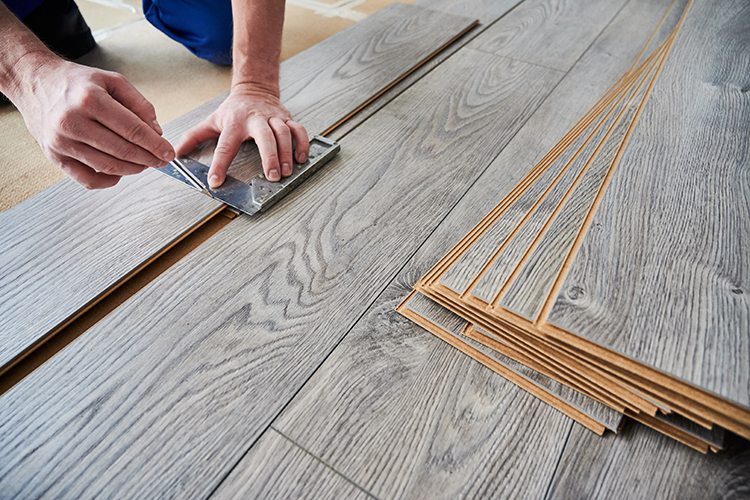
Welcome to our blog, where we’ll explore all things laminate flooring. Whether you’re a newbie or a seasoned DIY enthusiast, this guide will provide the information you need about laminate flooring.
Laminate flooring is a synthetic product designed to mimic the appearance of natural wood or stone. It is made up of several layers that are fused through a lamination process. The top layer, also known as the wear layer, is a transparent protective layer that provides resistance against scratches, stains, and fading. Beneath the wear layer is the design layer, which features a high-resolution image replicating the look of natural materials. The core layer, made of high-density fiberboard (HDF) or medium-density fiberboard (MDF), provides stability and strength to the flooring. Lastly, the bottom layer, known as the backing layer, serves as a moisture barrier and enhances the structural integrity of the flooring.
Laminate flooring comes in a wide range of styles and designs, allowing you to achieve the desired look for your space. Whether you prefer the rustic charm of reclaimed wood or the sleek elegance of marble, there is a laminate flooring option that suits your taste.


Laminate flooring offers several advantages that make it a popular choice for homeowners:
– Durability and scratch resistance: The wear layer of laminate flooring provides excellent resistance against scratches, making it ideal for high-traffic areas and households with pets or children.
– Easy installation and maintenance: Laminate flooring is designed to be installed as a floating floor, meaning it does not need to be glued or nailed down. This makes it a DIY-friendly option. Additionally, laminate flooring is easy to clean and maintain, requiring only regular sweeping or vacuuming.
– Wide range of design options: With laminate flooring, you can achieve the look of hardwood, stone, or tile at a fraction of the cost. The variety of styles and designs allows you to find the perfect flooring to complement your home’s aesthetic.
Despite its many advantages, laminate flooring does have a few drawbacks to consider:
– Water damage susceptibility: Laminate flooring is water-resistant but not waterproof. Prolonged exposure to moisture can cause the planks to warp or swell. It is essential to promptly clean up any spills and avoid installing laminate flooring in areas prone to water damage, such as bathrooms or laundry rooms.
– Limited refinishing options: Laminate flooring cannot be sanded or refinished, unlike solid hardwood flooring. If a plank is damaged or worn out, it must be replaced.
Installing laminate flooring can be a rewarding DIY project. Here is a step-by-step guide to help you through the process:
1. Preparing the subfloor: Before installing laminate flooring, it is essential to ensure that the subfloor is clean, dry, and level. Remove any existing flooring and repair any imperfections in the subfloor.
2. Measuring and cutting the planks: Measure the room’s dimensions and calculate the amount of laminate flooring needed. It is recommended to purchase a little extra to account for any mistakes or future repairs. Use a saw to cut the planks to the desired length.
3. Installing underlayment and vapor barrier: Lay down a foam underlayment to provide cushioning and reduce noise. If you are installing laminate flooring in a moisture-prone area, such as a basement, it is advisable to use a vapor barrier to protect against moisture damage.
4. Clicking the planks together: Start in one corner of the room and lay the first row along the longest wall, leaving a small gap between the planks and the wall for expansion. Connect the planks by clicking the tongue of one plank into the groove of another. Use a tapping block and a mallet to ensure a tight fit.
5. Finishing touches and maintenance tips: Install baseboards or quarter-round molding to cover the expansion gap. Use transition strips to connect the laminate flooring to adjacent rooms or different types of flooring. Regularly clean the laminate flooring with a damp mop or a laminate floor cleaner to maintain its appearance.


Laminate flooring is a versatile option used in various areas of your home. Some suitable areas for installing laminate flooring include:
– Living rooms, bedrooms, and hallways: Laminate flooring is an excellent choice for these common areas, as it provides durability and a wide range of design options to suit any style.
– Kitchens (with caution): While laminate flooring can be installed in kitchens, taking precautions to protect against water damage is essential. Wipe up spills immediately and avoid installing laminate flooring near sinks or dishwashers.
– Basements (with proper precautions): Laminate flooring can be installed in basements, but it is crucial to address potential moisture issues. Use a vapor barrier and consider installing a dehumidifier to maintain a dry environment.
The cost of laminate flooring can vary based on several factors. In London, Ontario, the average price ranges from $2 to $5 per square foot, including installation. However, the overall cost can be influenced by the following factors:
– Quality of materials used: Higher-quality laminate flooring tends to be more expensive. Premium options may feature enhanced durability, more realistic designs, and additional noise reduction or moisture resistance features.
– Installation complexity: If the installation requires additional preparation or involves intricate patterns or designs, it can increase the overall cost. It is advisable to obtain multiple quotes from reputable flooring companies to compare prices and services.
When choosing a laminate flooring company in London, Ontario, it is essential to consider several factors to ensure you receive the best product and service:
– Product variety: Look for a company that offers a wide range of laminate flooring options, including different styles, designs, and price points. This lets you find the perfect flooring to suit your needs and budget.
– Customer reviews: Review previous customer testimonials to gauge the company’s reputation and customer satisfaction. Look for reviews that mention the quality of the products, installation process, and after-sales service.
– Warranty offers: A reputable laminate flooring company should offer a warranty on their products and installation services. Knowing you are protected against manufacturing defects or installation issues provides peace of mind.


Here are some common questions about laminate flooring installation:
– Can laminate flooring be installed on top of existing flooring?
Yes, laminate flooring can be installed over certain types of existing flooring, such as vinyl or ceramic tiles. However, ensuring the existing flooring is in good condition and properly prepared before installation is essential.
– Do I need professional help for installation?
While laminate flooring can be installed as a DIY project, hiring professional installers can ensure a seamless and high-quality installation. They have the expertise and tools to handle any challenges during the process.
– Can laminate flooring be installed in bathrooms?
Laminate flooring is not recommended for bathrooms or other areas with high moisture levels. The constant exposure to water can cause the planks to warp or swell. It is advisable to choose a more suitable flooring option for these areas, such as luxury vinyl or ceramic tiles.
Conclusion
We hope this guide has provided you with valuable insights into laminate flooring. Whether considering a DIY project or seeking professional assistance, make an informed decision based on your needs and preferences. Laminate flooring offers an affordable and stylish option for transforming your space. Explore the possibilities and enjoy your new floors!
Remember, if you have any more questions or need further assistance, please contact us. Happy flooring!



